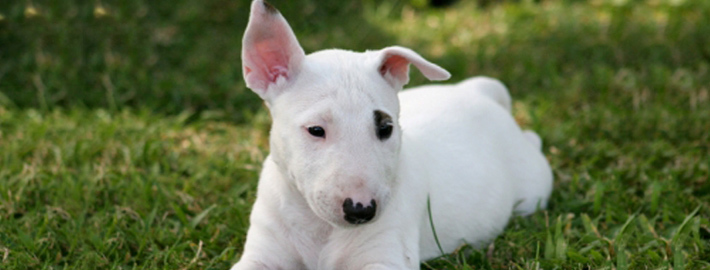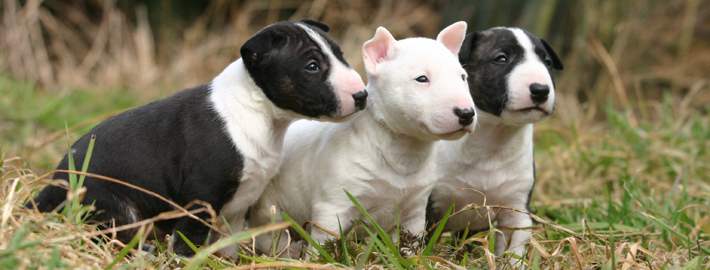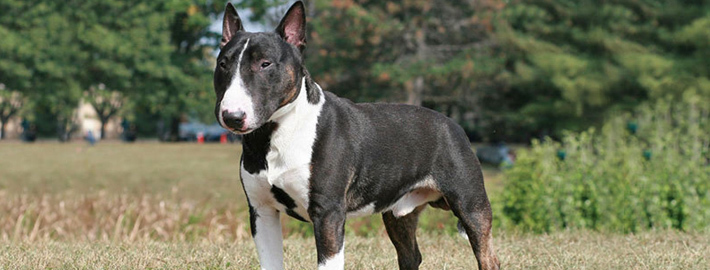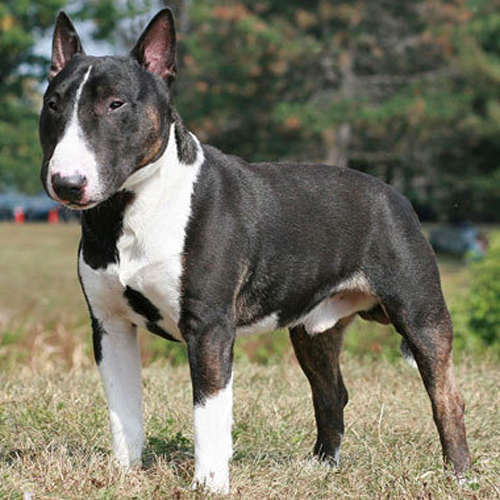What makes the Miniature Bull Terrier Unique?
Miniature Bull Terrier is comical, lively, playful and mischievous. Despite its smaller size, it is not a lap dog. It is every bit as tough as the larger version and apt to want to prove itself even more. It is a sweet clown, devoted but not fawning. It is stubborn and independent and needs to be trained with a firm yet gentle hand — and a good sense of humor. It likes to play and investigate. It likes to dig, and it needs ample exercise.
Page Contents
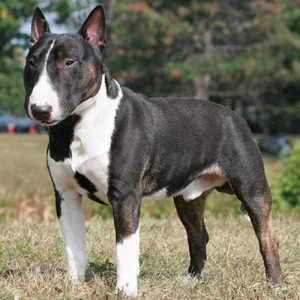
SnapShot
| Size: | Males – 25 to 33 cm (10 to 14 inches) Female – 25 to 33 cm (10 to 14 inches) |
| Weight: | Males – 11 to 15 kg (24 to 33 pounds) Females – 11 to 15 kg (24 to 33 pounds |
| Origin: | England |
| Life Span: | 9 – 15 Years |
| Colour: | Fawn & White, White & Black Brindle, Brindle & White, Tri-color, Red & White and White |
| Litter Size: | 1 puppy to 9 puppies, 5 being the most common |
Is the Miniature Bull Terrier Right For You?
This is a strongly built, square-proportioned dog, big-boned but not coarse. It should reflect those attributes that made the standard-sized bull terrier a formidable foe in the fighting ring with its sturdy bone and muscle and strong jaws. Its gait is free and easy. Its skin is tight and its coat is short, flat and harsh. It wears a keen and determined expression on its characteristic clown face. The strongly built, active and determined Miniature Bull Terrier is often described as clownish and fearless. Although fond of both grown-ups and children, they may become too energetic for small children without the proper exercise and training. They are not recommended for families with other non-canine pets such as hamsters and guinea pigs. This easy to groom breed requires only occasional brushing.
In 5 Words
- Playful
- Energetic
- Courageous
- Even Tempered
- Stubborn
Characteristics
Learn About the Miniature Bull Terrier
Description
Miniature Bull Terriers have short, fine, and glossy coats that are very close to the skin, like the Bull Terriers. They are accepted in the ring to be white, white with another color, or fully colored. However, like the Standards, any blue or liver colored coats are undesirable. These dogs require minimal grooming.
In the early 1900s, the difference between the breeds was determined by the dog’s weight. However, this led to Miniature Bull Terriers becoming so small and fine that they looked more like a Chihuahua than a Bull Terrier. So, in the 1970s, the weight limit was replaced with a height limit of under fourteen inches. They are usually no smaller than ten inches. According to the AKC, miniature bull terriers’ weight must be proportionate to its height. However, they tend to range anywhere from 20–35 lbs.
The Miniature Bull Terriers have a very bold build. They have very muscular shoulders and a full body. Like the Bull Terrier, they have a head described as “egg-shaped.” It is flat on top with a Roman nose. The eyes are triangular and closely set. The ears are carried erect and are not cropped or otherwise altered.The tail is carried horizontally rather than vertically.
Short History of the Miniature
The Bull Terrier (also known as an ‘English Bull Terrier’) was bred in England in the 1830’s by crossing a Bulldog with an English Terrier in an effort to build the ultimate fighting dog. The ‘Bull’ in ‘Bull Terrier’ derives from the popular practice of ‘bull-baiting’, in which several dogs were matched up against a chained bull. The Bull Terrier was later bred with the Spanish Pointer to increase its size, resulting in a highly successful, powerful, persistent fighter. After dog fighting was abolished, Bull Terriers were bred with the Dalmatian to produce a white colored strain, then again with the Staffordshire Bull Terrier to reintroduce color. Both the white and colored types increased in popularity as pets, and both strains remain today. Famous Bull Terriers include the Target mascot ‘Bullseye’, Spuds MacKenzie, who was used in Bud Light commercials (and later discovered to secretly be a female!), and Patsy Ann, a Bull Terrier from Juneau, Alaska famous for unfailingly predicting the impending arrival of ships to port. The Miniature Bull Terrier was first recognized by the American Kennel Club in 1992.
Temperament
Like the Bull Terriers, Minis are loving and, like many terrier breeds, they can be stubborn at times; but despite this they make great dogs for people with limited space.
Miniature Bull Terriers are known to be stubborn and courageous. They do not seem to realize their size, however, because even if confronting an enormous dog they will not back down. However, with the right training, confrontations can be avoided. They are very energetic and playful. They love people but care must be taken as they are variable around other dogs.
Caring for Your Miniature Bull Terrier
General Health
Miniature Bull Terriers are predisposed to developing eye lens discoloration. This causes blindness somewhere around 3 years of age or later. Blindness is the most serious problem within the breed. White dogs tend to have a problem with deafness. Deafness does not mean that the dog cannot lead a full and healthy life. There are simply different ways to catch his attention and training will be done with hand signals as opposed to words. Sub-aortic Stenosis, Entropion, allergies and mitral valve dysplasia also occur in this feisty breed.
Grooming & Bathing
Grooming for a Miniature Bull Terrier owner is minimal. Brushing the coat every week will keep the Mini Bull’s coat looking clean and shiny. When the dog is shedding, daily brushing is best. Bathing should be done every other month, unless the dog is exceptionally smelly. Dry shampoo is a great product to use between conventional baths.
Exercise & Training
The Miniature Bull Terrier is a highly active dog. He loves to run and play. A fenced-in backyard with plenty of toys will keep him happy however; a Mini Bull is quite happy living in a large apartment provided he is walked regularly. Walks must be brisk and relatively long to keep him in great shape. Remember, he will still go rip-roaring through the house to stretch his leg muscles and… just to have fun. Without proper exercise, Miniature Bull Terriers often become destructive. They can tear up a house and destroy the furniture in no time at all. Exercise and mental stimulation through play are essential to the Miniature Bull Terrier’s well-being, as well as that of your belongings. Miniatures are independent and stubborn and do require a lot of training, particularly early on. They must be heavily socialized at a young age and trained to obey early in their lives. They also are very energetic and seem to be able to play endlessly as puppies. However, as they grow older, they become less energetic. They must be carefully exercised and dieted to avoid obesity.

